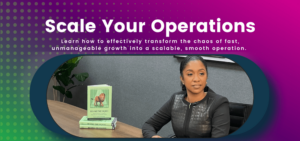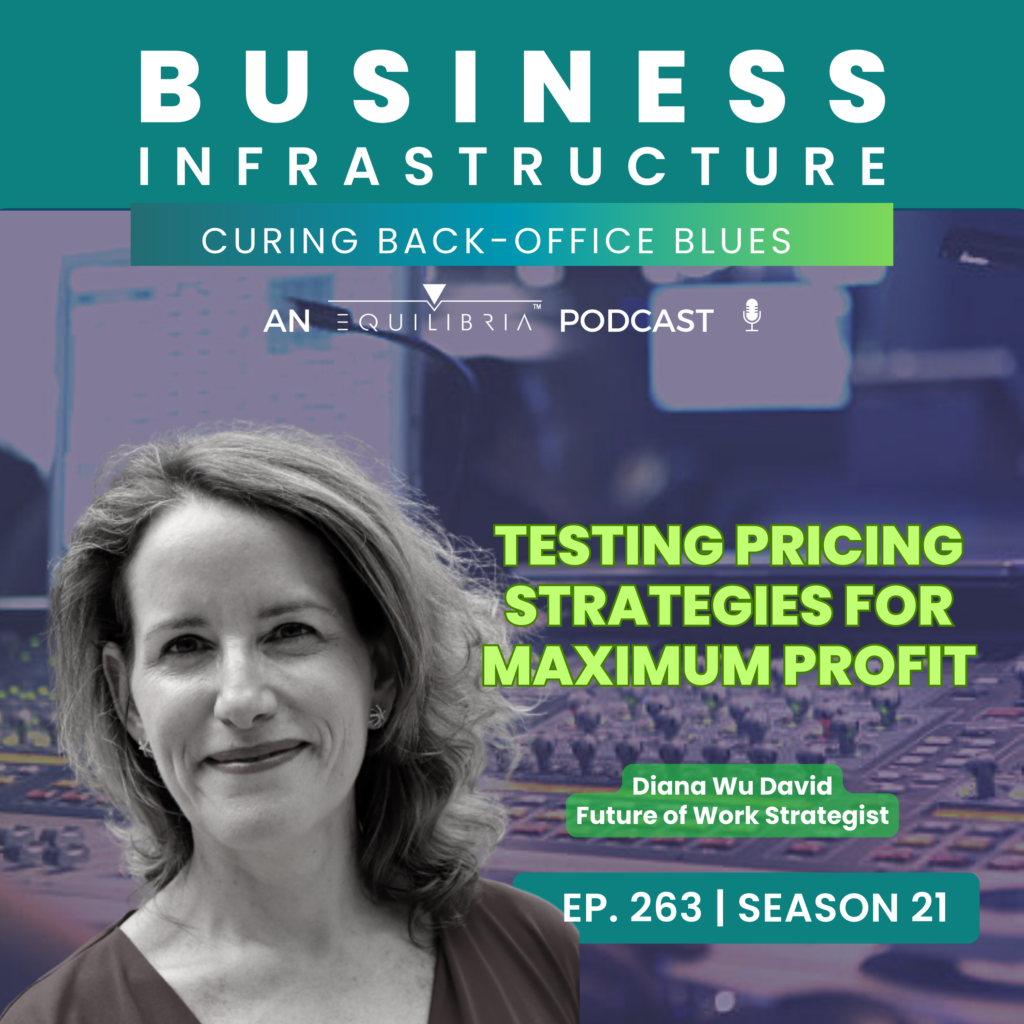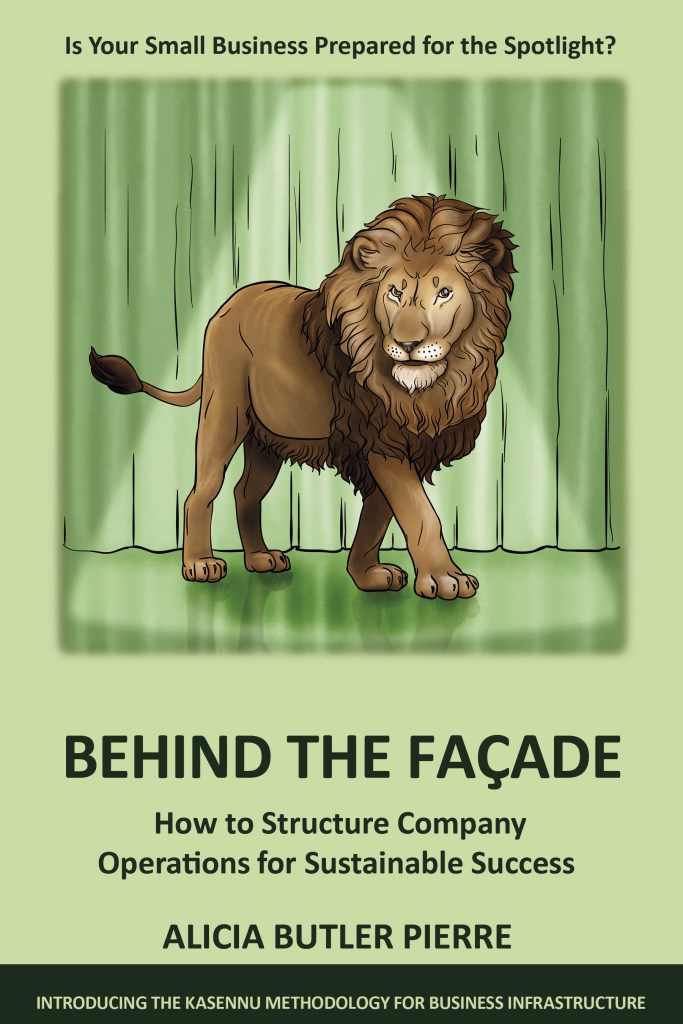Transcript
Hi! Thanks so much for stopping by again. I know why you’re here, so let’s head toward the podcasting vault. Ooh, the door seems heavier than the last time. Go ahead and have a seat. By the way, how have you been? I’m sure you’ve been busy but trust me, this episode is worth your time.
This podcast is brought to you by Equilibria, Inc. We design business infrastructure that frees you from the chaos of fast growth while scaling your operations to the next level.

Welcome back to Season 21 of the Business Infrastructure podcast. On this show we share operational tips, strategies, and tactics to help you cure any back-office blues you might be experiencing. I’m Alicia Butler Pierre and this season we’re pulling some of our older episodes off the shelves of our podcasting vault. These are episodes that created quite the buzz when they first aired and deserve to be brought back to life using our show’s new format.
So, without further ado, let’s head to Hong Kong. It’s the home base of our VIP guest who has deep experience in pricing products and services as well as deep expertise in futureproofing your work. And she’s here to share her pricing process with us.
This is Episode 263 – Testing Pricing Strategies for Maximum Profit with Diana Wu David
Diana, welcome to the show. How are you today?
I’m wonderful. Thank you so much for having me, Alicia.
Diana we’re actually going to talk about something that used to be an Achilles heel for me to just be very honest, and that is pricing. Being that you’ve started two companies and you’ve worked for several other companies across the US, Europe, and Asia, you obviously know a thing or two about pricing. But can you first tell us a little bit more about your businesses and what your specialty is?

So, I would love to talk about pricing, and I think it’s an Achilles heel for all of us. Over the years, I have even now found that I know intellectually that it’s an important thing for us to do, but I still have to call one of my best friends and business advisors when I want to really raise. I’m sure it’s in the back of many people’s minds, and she’ll say, “Oh, come on, get over yourself. Just do it!
What’s the worst that can happen?” So, with that spirit in mind, let me tell you a little bit about my business and maybe a little bit about my past, so that people who have slightly different businesses can understand that I know where off I speak, and that I have done a number of different things that might apply to them and help them. So, my business now is Serrana Labs.
It consists of preparing people for the future of work based on my speaking, based on my online courses on future proofing, and based on my consulting to CEOs boards, and businesses in terms of gathering them together to prepare for the future and to even prepare themselves in terms of their behavior and the way that they work as a team.
In the past, I’ve been in and out of small businesses that I started up myself, as well as large corporations. My last large corporate job was working for ten years for the Financial Times, where I was in charge of circulation across the Asia Pacific. That is one of the reasons I know a lot about pricing because I was in charge of pricing every year customer segmentation and really the strategy to maximize revenues and profit for that business. And then in the past, I’ve been a management consultant.

I have had my own company again in the United States, which was selling to high-end retail Neiman Marcus and Bloomingdale’s and the like. So, I’ve had a long-checkered past, and most of it’s been around strategy and running large businesses, or in my case, aspiring large businesses in terms of strategy, sales, marketing, and execution.
With such a rich and diverse background across many industries and sizes of companies, it’s clear Diana has seen and done a lot and knows a thing or two about pricing. I asked if she could start us from scratch. That is, could she start describing her recommended pricing process for a new product or service?
I think for the pricing for your initial product, of course, it’s easy to do market research to see what other people are providing and how your product fits into that niche. I am all about research in the initial stages before I launch a product, even for the books that I’ve done. One of them was a children’s book and is still, seven years later, on tens of thousands of copies.
And really, I attribute that not to my brilliant marketing, but really to filling a niche. Clayton Christensen, who’s a Harvard Business School professor, has written a lot on rather than, for example, McDonald’s selling milkshakes, they realized that a lot of people were going through the drive-thru to get something quick that they could have in their car on their way to work to just fuel themselves. And so, he realized that actually they could start selling breakfast smoothies in the morning or that kind of thing, because people were buying milkshakes.
That is something that I think about when I think about my products or my service. What job is this doing for my customer? It’s not just the product. It’s really about the value that you’re bringing to them. And you may have to change the product a bit to make that even more enhancing.
It might be the process in their own business and how it fits into that. That is the first step, I think, in terms of determining what it is you’re selling. And it may not be exactly what you think you’re selling and then to see what people are paying to get that job done. And from there you can have an array of pricing.
Okay, so step 1 of Diana’s pricing process is figuring out the value your product or service provides from your customer’s perspective. Pay attention as she shares an example from her days working at the newspaper, Financial Times, to illustrate her point.

I started there long enough ago that that was really the main thing people were buying. But truly they’re trying to make better business decisions. Financial Times is a business newspaper, and it is global. So, it gives an international perspective. And when you think about buying a newspaper, people think, I’m not going to pay more than $5 for a newspaper.
That’s what we’ve been conditioned to do. But when you talk to people about using it to make better business decisions in the same way that they use your podcast to make better business decisions, then all of a sudden it becomes this trusted information source on par with a research report you would pay $100 for or a class that you would pay multiple thousands of dollars for, potentially.
One of the things that I tried to do was find new products that fulfilled the same need that people were willing to pay higher amounts of money for. And we launched a board training program where instead of paying $5, people will go through for six months and pay $10,000. Same assets. On my side, the journalists, the people who have great ideas, they’re up on things in terms of the latest research and same audience even, but different packaging and different format and different job to be done. So that I think is really important.
Step two of Diana’s pricing process is, well, as she said her friend told her, “Just do it!” In other words, set a price for your product or service. Don’t be surprised if you have to tweak the price because, at this stage, pricing is really about experimenting.

Being able to start to test, to put a price on it, and test what kind of response you get is something that we as small businesses in particular, don’t do. We’re like, “I’m going to put a price on it and that’s going to be the price,” right? And there’s some authenticity, right? You don’t want to go out with like 16 prices and all of a sudden, the people who are your customers are talking to each other and you look like you’re gouging them.
Find one price. For people who are out there doing it online, there’s something called A/B testing which is putting out two different versions and it’s not always about a price, but it’s two different or three different versions of an email or an offer and see what the response is.
In fact, I wrote a book that is geared towards smaller entrepreneurs and people starting in that realm Future Proof that is about minimum viable products for yourself, and for your life. And it is about taking those small bets and saying, “Okay, I am going out there to test your product.”
This brings us to the next step of Diana’s process – raising your prices. To illustrate her point, Diana shared another example of how she came to test the pricing of other services stemming from her book.

Raise your prices until you reach a point where people really balk at it, and it will be higher than you think it is. For my speaking. I did that once I got to about $5,000 US in a really slapdash way, I was like, “Okay, let’s make it 10,000.” And then by that time I had an agent and said, “What’s missing between five and ten for my speaking?”
And she said, “Well, you need to have this marketing collateral and maybe you should have a speaker reel.” Before that I had nothing. I had absolutely no web, nothing. So yeah, always trying to figure out what is that. That’s sort of the fourth step. What is between A and B that would allow me to raise my price? That next level, that next quantum leap
So, I agree with you about raising your price until they actually balk. But for people who are listening, they may be thinking to themselves, Oh my goodness, I don’t want to upset anyone. I may offend a customer that may never return to me.
So, there’s some risk involved once you’ve tested and you find that maybe people are not balking at your price for your product or your service, at what point, Diana, does it make sense to say, okay, maybe now it’s time to raise my pricing again? One thing that I’ve always said is, especially as companies are growing really fast and you have more demand than you can actually keep up with, raising your price is a surefire way to kind of stifle or choke that demand, but that may only be temporary.
So, you’re totally right. And I would say the caveat for speaking is that your customer is different all the time. It’s not that common for some kind of conference or company to have you as a keynote every single year.
So, in that sense, it’s a little easier. You don’t have to worry about returning customers. I would say that once you get to a point where you feel like you have raised your price and it’s in a somewhat stable place and you don’t feel like you’re leaving a lot of money on the table, that segmenting your customers so that you understand that your kind of getting everyone on that customer segmentation curve. So, the parallel that they use in economics is the gym. And there are some people who will go all the time to the gym, and you want to get those people in, and then you want to get them into the most premium package.
Or if it’s not the gym, it’s the telephone. Companies all over do this. So you figure out who those high-priced people are and what kind of value you can provide to them. And then you can think about maybe people who would like to not be able to afford that. Or not.
Want to think about paying that or just want a piece of your service or product and then so on and so on down the line. As somebody who once launched a business selling to retailers with four colorways and I think 150 SKUs, I’m a big fan of simplicity. That was such a disaster. Mentally, I think that kind of always thinking about having a span a customer segmentation for people, if that’s the way that your business is, is important. And I suppose you can go up or down that curve in terms of what you provide and at what price.
Diana just described the fifth step of her pricing process – segmenting your customers and offering different price points. Since one price does not fit all of the people who have some interest in your products or services, it’s smart to offer different price points to make sure you maximize reach, impact, and profitability. True to fashion, Diana offered another example to illustrate this point.
When I speak to large corporations, I know that I can sell to them a consulting package that could be in multiple countries and could include multiple teams, et cetera. And they just have Those are two totally different prices and different values. It’s one person. We can do it on Zoom. I don’t have to get on a plane. Their business is generally far simpler. There aren’t multiple stakeholders. That’s something to think about, making sure that if you have enough space in your business to have different products at different points, then you can just maximize the penetration of your product or service, and it’s also an optimum way to grow so much more complexity in terms of their workforce planning, in terms of their strategies, in terms of the number of things I might need to do.

The price will be high, the value will also be higher, and the complexity that I have to deal with and maybe new people I need to bring in will be hired versus an individual or even a single entrepreneur who says, “I just read your Future Proof book and I’m really inspired by it. My life is completely out of whack, and I need to kind of get things back together. Can I have half a year of consulting with you or coaching with you?”
Those are two totally different prices and different values. It’s one person. We can do it on Zoom. I don’t have to get on a plane. Their business is generally far simpler. There aren’t multiple stakeholders. That’s something to think about, making sure that if you have enough space in your business to have different products at different points, then you can just maximize the penetration of your product or service, and it’s also an optimum way to grow.
One strategy we often implement here at Equilibria is to offer three price points for consulting gigs with larger corporations. We intentionally place the option that we really want the client to select in the middle. The lower-priced option includes some type of Do-It-Yourself model and the third is a premium option. This is similar to the pricing options that many cloud-based software solutions offer. I asked Diana for her feedback on this approach.
I think that’s a great way to test because that’s really trying to find out what your customer wants and letting them decide what price point, they would like to be at. And over time, you might find that if everybody’s picking a certain one, then that’s feedback, that idea of testing and sort of really being intentional about the feedback and refining the process is important.
And I totally agree that also you’re trying to get a better sense of what you can offer to a person. So that person might buy the middle package that you’ve provided to them, and they may actually upgrade over time, or they’ll do that particular service from you and then they’ll say, that was great, but I know that you have something even better. It’s like upgrading a car.

Exactly! Another example that comes to mind is a car wash. You can run your car through the car wash on your own, or you can actually have it personally detailed. And there’s usually all of these different packages. But the whole point is they aren’t leaving any money on the table.
I think the other thing to think of psychologically because I think that the biggest problem, we have with pricing is often our mindset and being able to say, “Look, if you want this, you can access it in all kinds of different ways.” So, for me, I think of some people writing a book and they just feel excited that they wrote a book.
But I feel like for my book, that is my lowest price offering. If you want to understand my thinking, then you can buy a book for whatever price it is, $10, and that’s fine. And if you need a little bit more help after that, then you can do a course where we collect a community of people to help each other. And because they’re all putting in their time, in a way, it lowers the price. They’re really helping each other as opposed to me helping them.
And then you can have me help you, and then you can have me help your company. And I haven’t gotten to the fly-me-in-a-private-jet-to-your-private-island part of my business yet, but that’s next for sure.
Now that we know all five steps of Diana’s pricing process, it seemed appropriate to talk about the other elements of business infrastructure. Business infrastructure is a system for linking people, processes, and tools to scale operations in a repeatable, sustainable, and profitable way. I asked Diana if she wouldn’t mind sharing more about the people and tools she uses to price services and products.
Yeah, absolutely. We alluded to one of them in terms of A/B testing. And my business largely uses sales and marketing via the Internet. So, if I want to sell more copies of my book or more copies of my course, then I send an email out or I can do a pricing offer. One way to test the price that I found is to do a time-limited offer. So, for example, for my Future Proof course, it may be at $2,000, but I will try to do a short window for discounted offers, and I’ll do that through the Internet.

I think in other businesses, you can do it in a store. It’s like the one-week sale or whatever it is, just to see how many people really value your product or service but are maybe a little more sensitive to pricing and how many people will sign up at a lower price so that you might decide, now I have the gold-plated version, but maybe I’d like to do a shorter course or something that is just a 1-hour webinar, whatever it is.
And in terms of the people, I’m a zealot in terms of where process meets people, because for my consulting business and for my management consulting background and almost everywhere I’ve been, it’s where process and people meet that things fall apart, right?
Including myself.
Hmm…what does Diana mean by things falling apart where process and people meet? And why does she include herself in that? Coming up after the break we’ll explore that and offer resources to assist you in developing and testing pricing.
In the world of business, success isn’t just about great ideas or products. It’s about having a strong foundation—a solid business infrastructure. But why is it so important?
A robust business infrastructure is like the backbone of an organization. It provides the necessary support for all our operations.
Business infrastructure ensures effective communication and collaboration. It allows teams to seamlessly share information, work together efficiently, and make informed decisions.
It also enables efficient data management. With proper systems in place, businesses can securely store, analyze, and utilize their data to gain valuable insights and make strategic decisions.
Thirdly, a strong business infrastructure promotes innovation and growth. It provides the flexibility to scale up operations, adopt new technologies, and adapt to changing market demands. It’s no wonder why a solid business infrastructure is essential for success. It enhances communication, facilitates efficient data management, fosters innovation, and enables flexibility—all vital for businesses to thrive in today’s competitive landscape. Invest in a strong business infrastructure, and watch your business reach new heights!
At Equilibria, we’re excited to offer a free webinar opportunity where we’ll do a deep dive into business infrastructure. Stop being a victim of unmanageable fast growth and start building your own company’s business infrastructure. Don’t wait! Experience the order and calm that thousands of other small businesses have. Sign up now at SmoothOperator.Club. That’s SmoothOperator.club.

Thanks for coming back. Before the break, pricing, and future of work expert Diana Wu David shared her five-step pricing process. As we started talking about business infrastructure, she alluded to the fact that even she is guilty of falling victim to things falling apart when people and processes meet. What did she mean by that? Here’s Diana.
Well, I started out my career in management consulting, designing these beautiful processes. And then when you got them in the hands of people, people either didn’t understand what the purpose was and they didn’t want to change their own process, or it wasn’t explained properly, or it wasn’t thought about very well. While that was for large corporations, the reality is that there are a lot of processes in your own small business that can be there. The parallel would be when you install a new accounting software system, and managing your pricing in some accounting software can be very tricky. If you have your price to be at $10 for a day and then $20 for the next day, and the full price is 100, all of a sudden, if the people on the back end are not actually changing the prices or if you don’t have a nice process for testing the prices and kind of getting a sense of how that went and maybe why,
That, I think, is where it breaks down. When you just sort of randomly put things out there and you’re not thinking. Sometimes for very small businesses, and I have been guilty of this, you can have moments where you try to do a high price and then you get it.
But you don’t think, Wow, why did I get a higher price? What went into that product? Or even the sales process that allowed it to happen? And so that’s why I think when you put out something that’s a discount, and you get ten of 100 people to sign up, and you go through and reflect on some of your sales, first of all, ensuring you have the right billing system, ensuring you have all of the processes, the other back end processes aligned to ensure that you fulfill that properly so that you’re not billing people in different ways.
And then really looking at it. And you can do it as simply as using an Excel spreadsheet and saying, this was my test. I had one week at this date for $10, and ten people signed up and then actually went out. If you have the opportunity to ask people, why did you sign up? What made you sign up at this price and at this time?
And people, depending on the quantity, often will tell you, “Oh, it just happened to be the timing.” And so, then you’re looking at your data and thinking maybe it was the price, but maybe people will pay more for something or in September or whatever it is, like really using your data to understand when people will pay and for what is something.
That’s sort of a back-of-the-envelope process for me in terms of the way I do it in my business. When I worked at Financial Times, we would say, “Okay, we know that entrepreneurs in Atlanta who have just had their coffee will pay more for our subscriptions than somebody else.” It’s a lot of data over. 105-year-old companies and big companies are doing that increasingly. And I think small companies really need to start doing that more.
Diana’s right, as small business owners we should leverage more data to make pricing decisions. But it’s one thing to agree on the importance of this and another to actually implement it. What advice does Diana have to help us get started?
Well, I think if you’re really worried about raising your price, you could start with a focus group of people in your potential segment. And an example of that would be if you have a consulting business and I would make it not necessarily your existing customers, but you can gather together people to find out whether or not they’d be willing to pay a higher price or a different price.
If you’re already quite high-end and looking to go lower to capture more market share sit around and actually ask people, what would a product or service look like? That was twice the price of my current product or service. The reality is that you may get feedback where they say, “Oh, there’s nothing you can do for me that’s going to make me pay 100,000 instead of 50,000.” Certainly, that’s a possibility. So, if you’re really uncomfortable, you can gain a lot from in-person focus groups.
And in case you’re wondering, focus groups don’t have to be expensive. It’s possible to do them on a shoestring budget. In fact, Diana mentioned gathering around six people in your office or home and paying for someone to facilitate the focus group.
I actually did that for one of my businesses and it was hugely helpful. And I actually had a management consultant person who was interested in becoming an entrepreneur. It’s my little secret tip. Come and run my focus group and actually put together what people wanted from the business.

And then my favorite very low-effort advice would be to just try it. Put up a web page, put up a price, do an email campaign, or depending on your business, you can do advertising or some Facebook ads and see if anybody will buy it. And so, I do that more times than I’d care to admit.
It’s what I did when I launched my course, and I called it a beta course. We’re just wrapping it up now. I thought people keep telling me that they wanted more handholding, but were they really willing to pay for it? I don’t know. Let me put up one web page with a signup sheet and see if people are willing to sign up and then also pay for it.
And if I get two people, then I have my answer. If I get 100 people, then either way I have my answer. And I thought it was entirely possible that not a single person would sign up. And it’s a really rough draft. And so, we have 15 people signed up.
They’re all paying lots of money. I had so many people tell me, “Nobody pays for online anything, there’s no way.” And so, I really was pessimistic, but I thought, I’m willing to deliver on this if enough people sign up. And frankly, if two people had signed up, I would have said, “You know what, I really feel grateful that you are interested in this, but I don’t think I’m going to do a six-week course for you guys. Why don’t we just do some one-on-one consulting?” Then I don’t have to do 40-plus hours of video and an entire curriculum.
This is a key point because experimenting doesn’t mean that you should completely build something first and then wait to see if you can get customers for it. Research is key for effective experimentation.
Yes, that was my revelation and that is why I’m here. Spreading the gospel of high prices and viable products.
And part of Diana’s gospel includes resources from her pricing toolkit. There’s one tool in particular called Active Campaign that she highly recommends. It’s an email management tool.
Active campaigns can tell me, did that person click and what was the open rate? And once they got to the website, did they click open? What I will leave you within your business is really the idea of a minimum viable product and trial and error. I know that sounds very unscientific, but that’s certainly one of them. The other classic resource is The Lean Startup, which is a book by Eric Reis. And he pioneered the idea of not building it and waiting for them to come but really trying to put in a very basic level of operations, even for starting your entire business.
And then iterating from there based on what kind of feedback you get. My book is like the Lean Startup for people. My background has focused on digital transformation and starting companies within corporates, and starting companies outside of corporates. Based on that initial TED Talk and conversations with a lot of entrepreneurs and people who were in their sort of second act, I decided to do a book called Future Proof, which is Reinventing Work in the Age of Acceleration, which is really about looking at your life from a similar lens of innovation or a similar lens of sustainability.
One of the things in the book is the minimum viable lifestyle. So really think about the overall costs of your lifestyle because many people don’t become an entrepreneur because they feel like they can’t possibly leave their comfortable corporate job, or they can’t possibly change the lifestyle that they have. But really taking it down to a sort of minimum aspect and then being able to add opportunities on top of that and add your dreams on top of that is a concept that has allowed people to rethink their own cost structures as it relates to their work and their business.
A lot of it is similar ideas to what we’ve just been talking about, which is really that the world is going very fast, and you have to be adaptable. You have to have a higher adaptability quotient in addition to your IQ and your EQ. And you really have to think about what are some of the adjacent possibilities that I can go to.

So not a lot about pricing, but certainly about similar concepts of really trying to adapt and grow on a pretty constant basis.
Diana, how can people get in touch with you?
I have a website which is DianaWuDavid www dot Diana WuDavid. And there are lots of blogs related to being adaptable and agile and working remotely and that kind of thing. A lot of Future of Work blogs and different podcasts. And my Ted Talk is on there. And there’s also something for people who are interested in future-proofing, which is Eleven Questions About Your Future.
I feel super passionate about entrepreneurs, taking this because it’s a lot about the resources that you have in your life that will allow you to go into the future with the right structure for your friends and your relationships, the right support for yourself, understanding that you’ve thought about what will happen if your business or your career isn’t as relevant and how you can pivot to other things.
So, it’s really a question to ask yourself, am I ready? Am I ready for the future? Entrepreneurs are always so busy and so focused on their business, and it’s so easy as an entrepreneur to forget about yourself. That future-proof checklist, I think, is really important for them.
Well, we will definitely make sure we include a link to that. Thank you so much for all of this pricing wisdom. It’s much appreciated.

It’s my pleasure.
Alright, now that you’ve heard this remastered version of Diana Wu David’s original podcast interview, are you ready to reevaluate your pricing process? Remember, customer segmentation is key to making sure you don’t leave any money on the table.
Be sure to go to BusinessInfrastructure.TV to access links to Diana’s book, website, and TED Talk as well as the other resources she shared. Again, that’s BusinessInfrastructure.TV.
Thank you for listening! If you enjoyed this episode, then please subscribe and leave a five-star rating and review.

Okay, it’s almost time to take those headphones off. I need to close the vault until it’s time to feature our next remastered episode. Be sure to come back because we’re going to hear some techniques from the owner of a video production company for building a team of top-notch talent on an as-needed basis.
Until then, remember to stay focused and be encouraged. This entrepreneurial journey is a marathon and not a sprint.
This podcast was written, produced, and narrated by me, Alicia Butler Pierre. Audio editing by Olanrewaju Adeyemo. The original score and sound design by Sabor! Music Enterprises.
This is the Business Infrastructure – Curing Back-Office Blues podcast.























